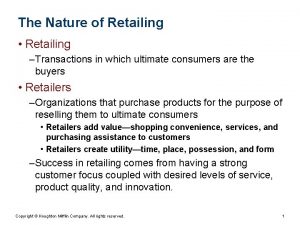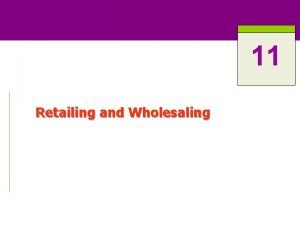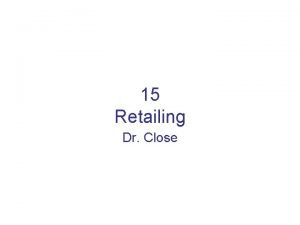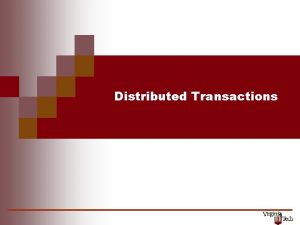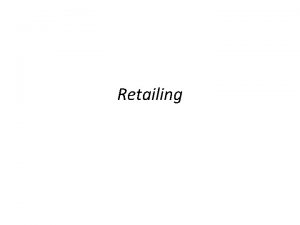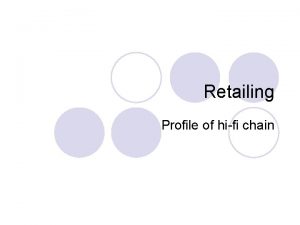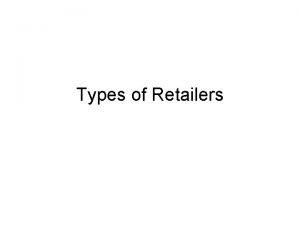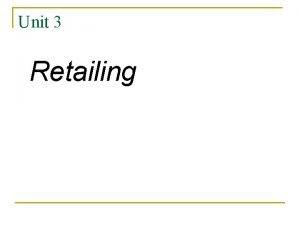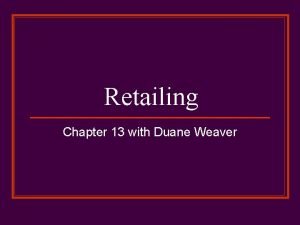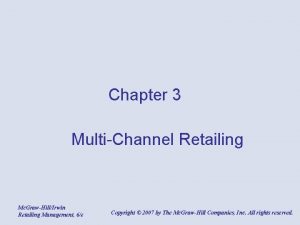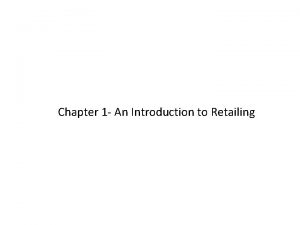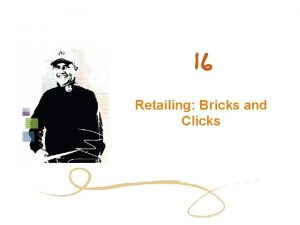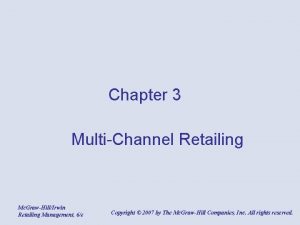The Nature of Retailing Retailing Transactions in which




















- Slides: 20

The Nature of Retailing • Retailing – Transactions in which ultimate consumers are the buyers • Retailers – Organizations that purchase products for the purpose of reselling them to ultimate consumers • Retailers add value—shopping convenience, services, and purchasing assistance to customers • Retailers create utility—time, place, possession, and form – Success in retailing comes from having a strong customer focus coupled with desired levels of service, product quality, and innovation. Copyright © Houghton Mifflin Company. All rights reserved. 1

Major Types of Retail Stores • General-Merchandise Retailers – A retail establishment that offers a variety of product lines – Department stores • Large retail organizations characterized by wide product mixes and organized into separate departments to facilitate marketing efforts and internal management • Goldsmiths, Dillards – Discount stores • Self-service, general merchandise stores offering brand name and private brand products at low prices • Walmart, Target – Supermarkets • Large, self-service stores that carry a complete line of food products, along with some nonfood products • Kroger, Schnucks, Albertsons Copyright © Houghton Mifflin Company. All rights reserved. 2

Major Types of Retail Stores (cont’d) • General-Merchandise Retailers (cont’d) – Superstores • Giant retail outlets that carry food and nonfood products found in supermarkets, as well as most routinely purchased consumer products • Walmart Supercenters – Hypermarkets • Stores that combine supermarket and discount shopping in one location • Carrefour (France), not successful in U. S. – Warehouse clubs • Large-scale, members-only establishments that combine features of cash-and-carry wholesaling with discount retailing (fewer items, large volume) • Costco beats Sams Club! • Costco in Japan…. Copyright © Houghton Mifflin Company. All rights reserved. 3

Major Types of Retail Stores (cont’d) • General-Merchandise Retailers (cont’d) – Warehouse showrooms • Retail facilities in large. low-cost buildings with large onpremise inventories and minimal services (consumers must do a lot themselves) • IKEA – Catalog showrooms • A form of warehouse showroom where consumers can shop from a catalog and products are stored out of buyers’ reach • Service Merchandise? Beat out by Warehouse clubs. • Brookstone – still doing well for xmas. Copyright © Houghton Mifflin Company. All rights reserved. 4

Major Types of Retail Stores (cont’d) • Specialty Retailers – Traditional specialty retailers • Also called “limited-line” and “single-line” retailers • Carry a narrow product mix with deep product lines (e. g. , pet supplies) • Have higher costs and higher margins • Provide more product selection (first-line brands), product expertise, and high levels of personal service –Foot Locker –Dilday TV –http: //www. buildabear. com/ Copyright © Houghton Mifflin Company. All rights reserved. 5

Major Types of Retail Stores (cont’d) • Specialty Retailers (cont’d) – Off-price retailers • Buy manufacturers’ seconds, overruns, returns, and offseason merchandise for resale to consumers at deep discounts • Charge less than do department stores for comparable merchandise and offer few customer services • Have established long-term relationships with suppliers for continuing supplies of reduced-price goods –TJ Maxx, Steinmart, Burlington Coat Factory – Category killers (rising in popularity! Killing small bus!) • Concentrate on a major product category and compete on the basis of low prices and product availability –Sports Authority, Home Depot, Bed Bath and Beyond, Toys R Us, Office Depot Copyright © Houghton Mifflin Company. All rights reserved. 6

Non. Store Retailing • Nonstore Retailing Defined – The selling of products outside the confines of a retail facility – Growth sector of retailing due to • Consumers are less willing to devote personal time to shopping in retail stores. • Poorly trained and informed retail personnel can’t offer needed sales assistance. • Growing population of older shoppers who tend to shop less in large stores. –Category Killers and Discounters –Overwhelming! –What happened to small hardware store? Copyright © Houghton Mifflin Company. All rights reserved. 7

Non. Store Retailing (cont’d) • Direct Selling – The marketing of products to ultimate consumers through face-to-face sales presentations at home or in the workplace • Party plans: hosting groups to view a product demonstration and encouraging participants to purchase the products • Tupperware, Mary Kay (now opening stores), Amway! – Benefits • Personal attention to customer • Convenience of time and place of presentation – Limitations • High costs make it the most expensive form of selling • Negative consumer view of direct selling Copyright © Houghton Mifflin Company. All rights reserved. 8

Non. Store Retailing (cont’d) • Direct Marketing – The use of telephone and nonpersonal media to introduce products to consumers, who then can purchase them via mail, telephone, or the Internet Copyright © Houghton Mifflin Company. All rights reserved. 9

Types of Direct Marketing • Catalog Marketing – A type of marketing in which an organization provides a catalog from which customers can make selections and place orders by mail, telephone, or the Internet • Consumer advantages are efficiency and convenience • Marketer advantages are lower location, facility, selling, and operating costs. • Disadvantages are inflexibility and limited selection and local service availability. • Speigel, Land’s End, JCrew • Frontgate • Victoria’s Secret (combines • With retail stores) Copyright © Houghton Mifflin Company. All rights reserved. 10

Direct Marketing (cont’d) • Direct-Response Marketing – A type of marketing that occurs when a retailer advertises a product and makes it available through mail or telephone orders • Telemarketing – The performance of marketing-related activities by telephone Copyright © Houghton Mifflin Company. All rights reserved. 11

Direct Marketing (cont’d) • Television Home Shopping – A form of selling in which products are presented to television viewers, who can buy them by calling a tollfree number and paying with a credit card • Online Retailing – Retailing that makes products available to buyers through computer connections • Automatic Vending – The use of machines to dispense products Copyright © Houghton Mifflin Company. All rights reserved. 12

Franchising • Franchising – An arrangement in which a supplier (franchiser) grants a dealer (franchisee) the right to sell products in exchange for some type of consideration • Franchiser furnishes equipment, buildings, management know-how, and marketing assistance. –Holiday Inn Express • Franchisee supplies labor and capital, and operates the business by the provisions of the franchise agreement. –Manager of local HI Express Copyright © Houghton Mifflin Company. All rights reserved. 13

Copyright © Houghton Mifflin Company. All rights reserved. 14

Franchising (cont’d) • Advantages – Enables business startup with limited capital – Provides developed and proven business to franchisee – Attracts customers with established brand name – Allows immediate market entry – Motivates franchisee to succeed • Disadvantages – Control over aspects of the business and its operations by franchiser – Expense of continuing franchise royalties and advertising fees – Lack of control of franchisees by franchisor Copyright © Houghton Mifflin Company. All rights reserved. 15

Strategic Issues in Retailing • Retail Store Location – Location, location • Types of Locations – Free-standing structures • Position relative to competition • Customer access and parking – Traditional business districts • Redevelopment of decaying downtown infrastructure Copyright © Houghton Mifflin Company. All rights reserved. 16

Strategic Issues in Retailing (cont’d) • Traditional Shopping Centers – Neighborhood shopping centers • Usually consist of several small convenience and specialty stores. – Community shopping centers • Include one or more department stores (anchors), some specialty stores, and convenience stores. – Regional shopping centers • Have the largest department stores, the widest product mix, and the deepest product lines of all shopping centers. Copyright © Houghton Mifflin Company. All rights reserved. 17

Strategic Issues in Retailing (cont’d) • Nontraditional Shopping Centers – Factory outlet malls • Shopping centers that feature discount and factory outlet stores carrying traditional brand name products – Miniwarehouse mall • Loosely planned centers that lease space to retailers running retail stores out of warehouse bays – Nonanchored malls • Do not have traditional department store anchors; instead combine off-price and category killer stores in a “power center” format –Home Depot is the anchor instead of department stores Copyright © Houghton Mifflin Company. All rights reserved. 18

Strategic Issues in Retailing (cont’d) • Retail Positioning – Identifying an unserved or underserved market segment and serving it through a strategy that distinguishes the retailer from others in the minds of consumers in that segment • Neiman Marcus • Store Image – Atmospherics • The physical elements in a store’s design that appeal to consumers’ emotions and encourage buying • Interior layout, colors, furnishings, and lighting • Exterior storefront and entrance design, display windows, and traffic congestion Copyright © Houghton Mifflin Company. All rights reserved. 19

Strategic Issues in Retailing (cont’d) • Scrambled Merchandising – The addition of unrelated products and product lines to an existing product mix, particularly fast-moving items that can be sold in volume – Intent of scrambled merchandising • • Convert stores into one-stop shopping centers Generate more customer traffic Realize higher profit margins Increase impulse purchases – Walgreens Copyright © Houghton Mifflin Company. All rights reserved. 20
 Nature of retailing
Nature of retailing Nature and nature's law lay hid in night meaning
Nature and nature's law lay hid in night meaning Determinace lidské psychiky
Determinace lidské psychiky Hát kết hợp bộ gõ cơ thể
Hát kết hợp bộ gõ cơ thể Frameset trong html5
Frameset trong html5 Bổ thể
Bổ thể Tỉ lệ cơ thể trẻ em
Tỉ lệ cơ thể trẻ em Voi kéo gỗ như thế nào
Voi kéo gỗ như thế nào Tư thế worm breton
Tư thế worm breton Chúa yêu trần thế alleluia
Chúa yêu trần thế alleluia Các môn thể thao bắt đầu bằng tiếng bóng
Các môn thể thao bắt đầu bằng tiếng bóng Thế nào là hệ số cao nhất
Thế nào là hệ số cao nhất Các châu lục và đại dương trên thế giới
Các châu lục và đại dương trên thế giới Công thức tiính động năng
Công thức tiính động năng Trời xanh đây là của chúng ta thể thơ
Trời xanh đây là của chúng ta thể thơ Mật thư anh em như thể tay chân
Mật thư anh em như thể tay chân 101012 bằng
101012 bằng độ dài liên kết
độ dài liên kết Các châu lục và đại dương trên thế giới
Các châu lục và đại dương trên thế giới Thơ thất ngôn tứ tuyệt đường luật
Thơ thất ngôn tứ tuyệt đường luật Quá trình desamine hóa có thể tạo ra
Quá trình desamine hóa có thể tạo ra
